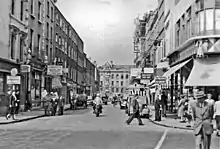Mercer's Hospital
Mercer's Hospital (Irish: Ospidéal Mercer) was a hospital in Dublin, Ireland. It was converted into a clinical centre and medical library for the Royal College of Surgeons in Ireland in 1991.[1]
| Mercer's Hospital | |
|---|---|
| Health Service Executive | |
 Mercer's Hospital (at the end of the Street) | |

| |
 Shown in Dublin | |
| Geography | |
| Location | Dublin, Ireland |
| Coordinates | 53.340704°N 6.263541°W |
| Organisation | |
| Care system | HSE |
| Type | General Hospital |
| History | |
| Opened | 1734 |
| Closed | 1983 |
History
The hospital has its origins in a house established by Mary Mercer for the shelter of poor girls in 1724.[1] Following Mary Mercer's death, in 1734, a number of eminent surgeons took over the running of the facility and converted it into a hospital. The political pamphleteer, Jonathan Swift, was on its first board of governors.[1]
To support funding for the hospital a number of concerts were arranged over the following years. The most significant of these was the first performance of Handel's Messiah, which took place in the Ancient Musick Rooms in Fishamble Street on 13 April 1742. To provide room for a large audience, ladies were requested to lay aside their hoops and gentlemen their swords. By this means an audience of 700 was crowded into the space, and the concert realised £400.[2]
The hospital was completely rebuilt to a design by J.H. Brett in 1884.[3] In the late 19th century Mercer's was one of the chief teaching hospitals in Dublin; it was located close to several schools of medicine, including Kirby's and the Ledwich school (run by Thomas Ledwich) in Peter Street. Ledwich's brother, Edward, became surgeon and lecturer at the hospital. Among other surgeons who practised there in the latter half of the 19th century were Edward Stamer O'Grady.[4]
In the late 1880s trouble broke out among the staff, leading to charges being brought against Dr. O'Grady, senior surgeon at the hospital. In October 1887 he was accused of insulting his professional colleagues to such an extent that they were unable to work with him. He had also charged one of the members of the board with loitering in the female ward for immodest purposes.[5] Some of the staff left. Lectures were disrupted and the numbers of students fell. The row continued into the 1890s until finally he and most of the staff were dismissed by the governors, and he refused to seek re-election. O'Grady died at home on 18 October 1897.[6] A new management team was appointed under the rule of Dr. ("Bull") Elliott in 1898: among them was Sir John Lumsden.[7]
The hospital closed in 1983 and was acquired by the Royal College of Surgeons in Ireland who converted it into a clinical centre and medical library in 1991.[1]
Notable physicians
Among the notable physicians who have been associated with Mercer's Hospital are:
- Francis L'Estrange (1756–1836), physician born in County Westmeath who was educated as a surgeon. In 1779 he was appointed Assistant Surgeon to Mercer's Hospital, where he later became surgeon. He was later appointed Assistant Surgeon to the House of Industry Hospitals, and surgeon to the Marine School. He engaged in obstetrical practice and was present at the birth of the poet, Thomas Moore (1779). He became president of the Royal College of Surgeons in Ireland in 1796.[8]
- John Lumsden (1869–1944), the Principal Medical Officer for the Commissioners of Irish Lights, Chief Medical Officer at the Guinness Brewery and founder of the St John Ambulance Ireland.[9]
- J. B. Lyons (1922–2007), a medical historian, writer, physician and professor of medicine.[10]
- Jonathan Osborne (1794–1864), of Cullenswood House, Dublin, appointed physician about 1830.[11]
- Robert Rowlette (c 1879–1944), a consultant and an independent Teachta Dála (TD). He was later a member of Seanad Éireann.[12]
At the bi-centennial anniversary of the hospital in 1934 the staff included: Charles B. Maunsell, Seton Pringle, Bethel Solomons, William de Courcy Wheeler and Gibbon Fitzgibbon. House physicians were Dr. Wentworth Taylor and Dr. Muriel Smiddy.[13]
References
- Mercer's Medical Centre Archived 14 July 2011 at the Wayback Machine
- "Mercer's Hospital". Irish Society for Archives. 1 September 2006. Archived from the original on 23 October 2006. Retrieved 5 May 2019.
- Fleetwood, 1983
- Fealy, p. 33
- Irish Times, October 1887
- British Medical Journal, 23 October 1897
- Lumsden, John (January 1935). "Personal Reminiscences of Mercer's Hospital". Irish Journal of Medical Science. London: Springer. 10 (1): 19–21. doi:10.1007/BF02957321. S2CID 70914252.
- Conroy, Pauline (2018). A Bit Different: Disability in Ireland. Orpen Press. ISBN 978-1786050601.
- History of The St John Ambulance Brigade in Ireland Archived 6 January 2010 at the Wayback Machine
- Irish Journal of Medical Science, Issue Volume 177, Number 2 / June 2008
- Dublin Journal of Medical Science, Volume 139, Number 3 / March 1915
- "Death of Dr. R.J. Rowlette" Irish Times 14 October 1944, p 1
- Irish Times, Bicentenary of Mercer's Hospital, 5 December 1934, p. 5
Sources
- Fealy, Gerard (2005). A History of Apprenticeship Nurse Training in Ireland. Routledge. ISBN 978-0415359979.
- Fleetwood, John F (1983). The History of Medicine in Ireland. Dublin: Skellig Press.
Further reading
- J. B. Lyons (1922–2007), Irish Journal of Medical Science, Springer London, ISSN 0021-1265 (Print), Issue Volume 177, Number 2 / June 2008
- Royal Irish Academy: The Dictionary of Irish Biography, edited by James McGuire and James Quinn. Dublin 2009
- Sonnelitter, Karen (2016). Charity Movements in Eighteenth-Century Ireland: Philanthropy and Improvement. Suffolk: Boydell & Brewer. ISBN 9781783270682